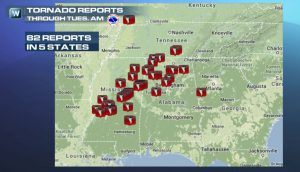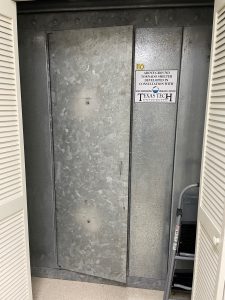
Growing up in east-central Mississippi, some of my earliest childhood memories revolve (get it?) around tornadoes. Collectively, we spent hours in tornado drills, curled into a fetal position with our heads against the wall and hands clasped over our heads. In first grade, I recall a lengthy tornado hide-out situation, after which we learned an actual tornado had come down the adjacent street and skipped past our school.
Last week, a tornado touched down near my hometown and caused so much damage that one of the local high schools had to close for several days. There’s a little community near Meridian called “Zero” that seems to be ground zero for tornadoes. I have lost count how many tornadoes touched down in that little town. In fact, one family was featured in a Timex “Takes a licking and keeps on ticking” ad in the 1990’s after their baby was swept from their trailer in the middle of a storm and found 15 minutes later, practically unscathed, hanging 8 feet up in a tree by his pajamas.

Earlier this week in Pensacola and throughout Escambia County, a tornado warning siren went off on cell phones and hurricane-like winds dropped tree limbs all over. In the deep South, April not only brings showers, but often tornadoes. So, what’s the deal? How are tornadoes formed, and why so many around here?
The United States wins the dubious honor of having the most (over 1000 annually), and most violent, tornadoes of any country in the world. This is primarily due to geographic features, including the warm, moist, low-pressure air coming off the Gulf of Mexico, which is met by cooler, drier, high-pressure air from the Rockies (and to some extent the Appalachian Mountains) that collides in a perfect (and windy) storm for cyclone production. As the high- and low-pressure air attempts to balance out, the air particles form a circular column of wind that moves along the ground. During a supercell thunderstorm, an updraft lifts that column of wind upright until it’s in the familiar funnel cloud shape of a tornado. The changing seasons of spring are the most common time for their formation, although tornadoes frequently spin off from hurricanes and occur throughout the summer and fall.

Due to their proximity to the Rockies, the midwestern tornadoes common in Oklahoma, Texas, and Kansas form a region known as “Tornado Alley.” However, a second region nicknamed “Dixie Alley” runs through that exact stretch I grew up in, along I-20 between Jackson, Mississippi and Birmingham, Alabama and the surrounding areas. These deep South tornadoes are sadly often more deadly. This is due to several factors, from the storms “hiding” amidst heavy rainstorms and hilly or forested topography, high population density, and the number of mobile homes in the area, which cannot hold up to the devastating winds.

Few Florida homes have basements, so internal rooms without windows (often a bathroom or hallway) are usually the best places to hunker down during an impending storm. For those interested, safe rooms can also be incorporated into new buildings and retrofit into older homes. If you are interested in seeing one in person, we have a metal tornado shelter in our windstorm mitigation building that you can check out. It was built using plans from Texas Tech, but there are many options available.
Another related potential weather hazard here on the coast is a waterspout, which is essentially a tornado that forms over the water. I saw my first one in person last summer (while on a boat!) and while a bit frightening, it was far enough away that I could watch in awe. If near one while in the water, the National Weather Service recommends moving 90 degrees away from the apparent direction of the waterspout. Waterspouts typically dissipate once they hit land, but it is possible for them to turn into regular tornadoes once they leave the water. Always use caution when stormy weather approaches.
 1
1
